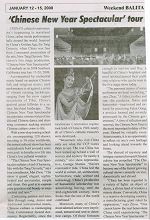Balita (Los Angeles): Chinese New Year Spectacular Tour
China's cultural renaissance isn't happening in mainland China, rather inside performance halls around the world. Inspired by China's Golden Age, the Tang Dynasty, when China was free from Communist persecution of the arts, New Tang Dynasty Television's live stage production, "Chinese New Year Spectacular" will embark on its 2008 Southern California tour Jan. 25-20, 2008.
Accompanied by orchestral music based on ancient Chinese folk and religious music, each performance is set against a series of vibrant rotating backdrops, ranging from the snow capped mountains in Tibet, China's pastoral green hillsides to a serene fairyland landscape. The Chinese New Year Spectacular incorporates various styles of traditional Chinese dance and stunning costumes making ancient Chinese culture come to life.
With a non-stop touring schedule encompassing 120 shows, traveling to 50 cities worldwide, the annual cultural show has been meticulously built around a common goal; to breathe new life into China's lost cultural wonders.
"The Chinese New Year Spectacular radiates a kind of harmony, like with the Tang Dynasty," says tour coordinator, Mei Zhou. "The show is grand, elegant, sophisticated and spectacular, simple and clean. Our goal is to express pure grandeur and beauty in ways ancient and new."
Conveying passion and emotion through song, dance and traditional instrumental music, Chinese culture is reemerging from Communist forced dormancy. Regrettably, since the totalitarian Communist regime took hold of China in 1949, nearly all of China's cultural treasures were destroyed.
"Westerners who visit China only see what the CCP wants them to see. The real China has been locked up behind a wall of secrecy and mystery for nearly a century," says show representative, George Stamm, "Before communist rule, China led the world in culture, art, architecture, horticulture, trade, science and technology. China's production of humanistic scholarship was astonishing, having, until the mid-eighteenth century, more books than the rest of the world combined."
Moreover, many of China's most talented artists were imprisoned, tortured and sent to detention camps. Of those fortunate enough to survive and flee., a handful of China's brightest and most talented passed their crafts onto relatives who can be seen in the live stage show today.
"The personal stories of some performers are heart wrenching," says Zhou. "A father, mother and son-conductor, flutist, and bassoonist-imprisoned and tortured for practicing Falun Gong, a practice banned and severely persecuted by the Chinese government." A time of reflection and renewal, the Chinese New Year is the most important holiday of the year. Shared by virtually every Asian country, it is an opportunity to reflect on one's own heritage and look ahead towards the future.
The shroud of mystery and intrigue centered around Chinese culture has propelled "The Chinese New Year Spectacular" to become one of the fastest growing cultural shows currently on tour, domestically and abroad.
"China has been regarded in a variety of lights: an object of desire, a divine land of wisdom, a remote dream. Conversely, China is a massive developing country, a manufacturing giant ruled by oppression," says Zhou. "One cannot know the real benevolent China until experiencing 'The Chinese New Year Spectacular.'"
